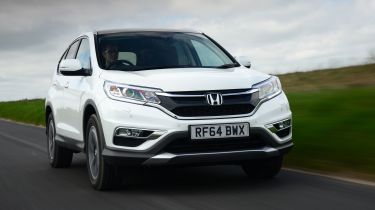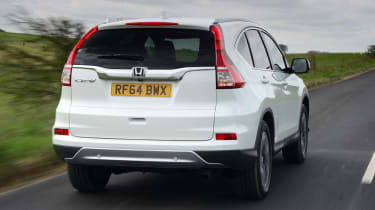Honda CR-V review (2012 - 2018)
The Honda CR-V is less engaging to drive than the class leaders, but it’s practical, comfortable and reliable

The Honda CR-V is known for its practicality. It was one of the first compact SUVs when it was launched back in 1995, and a 2015 facelift of the latest fourth-generation model has given the CR-V more of a premium feel than ever, without sacrificing anything in the way of usability.
On-paper economy is impressive, as is the car’s refinement, but the most appealing thing remains the Honda’s big boot. The crossover sector is crowded and the CR-V has many rivals, but the likes of the Mazda CX-5, Hyundai Tucson, Ford Kuga and Kia Sportage can’t match its spacious load bay, versatile rear seats and roomy interior.
Many of its competitors are more fun to drive, but the Honda is a relaxed motorway cruiser – although we’d suggest sticking to one of the diesel engines for the best balance of performance and efficiency. The bigger issue is the price, as a decent-specification Honda CR-V costs at least £25,000 – and there are some seriously talented alternatives that are considerably cheaper than that.
The Honda CR-V is a five-door SUV that’s a little too traditional – and large – to be counted as one of the more fashionable compact ‘crossover’ style SUVs. But it’s the crossover crowd the Honda CR-V must compete with, as well as other more traditional 4x4s. So the list of CR-V rivals includes such luminaries as the Nissan Qashqai, Skoda Yeti and Kia Sportage, as well as the Ford Kuga, Mazda CX-5, SEAT Ateca, Toyota RAV4 and Volkswagen Tiguan. Within Honda’s own line-up, the CR-V is a model up from the HR-V which makes it the biggest Honda for sale in the UK.
Used - available now
Like many of the more fashionable crossovers, the CR-V is no hardcore off-roader. It’s designed primarily as comfortable and practical road transport, and half the models on offer come with only two-wheel drive. The line-up starts with the Honda CR-V S entry model, which is reasonably equipped with 17-inch alloys, dual zone auto climate control, Bluetooth and DAB radio, plus cruise control, stop/start and city brake.
Next up is the CR-V SE Plus which adds parking sensors, fog lamps, and auto lights and wipers. Both S and SE Plus are available as Navi versions with the Honda Connect infotainment and Garmin navigation system. Moving up to the CR-V SR adds 18-inch alloys, HID cornering headlamps and half leather/half alcantara seats, while the top spec CR-V EX features a full leather interior, panoramic glass roof, plus smart keyless entry and start.
Depending on the model you pick, there’s a range of three engine choices. The 1.6-litre i-DTEC diesel comes with either 118bhp or 158bhp – the former available only with 2wd and a six-speed manual, and the latter available only with 4x4 and a choice of manual or nine-speed auto gears. If you pick the 2.0-litre i-VTEC petrol engine, you can choose two or four-wheel drive, and both with either manual or automatic gears.
The current Mk4 CR-V debuted in late 2011 and was revised in 2015, incorporating the company’s ‘wing grille’ corporate face in the process. It’s a well-established model though. The first-generation CR-V was on sale from 1995 to 2001 and was one of the early pioneers of the crossover-SUV formula, while the Mk2 was made from 2001 to 2006.
Meanwhile, the third-generation CR-V (2006-2011) had a curvier look as part of a radical makeover. By the time the fourth-generation car arrived in the UK in 2012, Honda had already sold more than five million CR-Vs around the globe in less than 20 years in production, proving what an important model it is for the company.
But the Mk4’s time is limited, with the European version of the 2018 Honda CR-V making its debut in prototype form at the 2017 Frankfurt Motor Show. There will be no diesel option, with Honda offering a choice of conventional 1.5-litre VTEC turbocharged petrol or a new petrol-electric hybrid.
The hybrid is expected to feature an all-new Intelligent Multi Mode Drive (i-MMD) twin-motor setup, comprising an electric motor, a 2.0-litre petrol engine, plus a separate electric motor generator.
A conventional gearbox is ditched in favour of a single-fixed gear ratio, with the system shuffling between driving modes depending on conditions and how the vehicle is being driven. Further details are expected in 2018.
In an effort to shift stock of the outgoing version, Honda has unveiled a new S Plus trim level, available with a 2.0-litre petrol for £23,500 or a diesel for £24,500. The special edition features body-coloured bumpers, tailgate and spoiler, a host of upgrades and four different paint schemes to choose from. Honda says the complete package adds up to £1,500 worth of extras for free.













